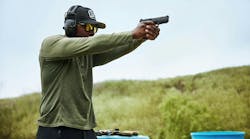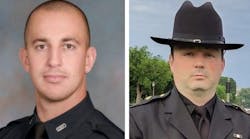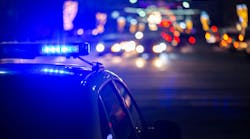The frenetic investigations which followed the October 2001 anthrax letter threats compelled law enforcement to devise new strategies to detect, stop and trace biological pathogens.
The search continues for the perpetrators of the anthrax crimes, but the good news is a new law enforcement discipline, known as microbial forensics, was found in the process.
Microbial forensics combines principles of public health epidemiology and law enforcement to identify patterns in a disease outbreak, determine which pathogen may be involved, and, when possible, trace the organism to its source. Microbial forensics uses the "biological fingerprint" of an infectious organism to help pinpoint the source, giving police and health officials a better chance to respond effectively to a biological threat.
Investigating evidence on the microbial level tends to raise the forensic bar. Since investigators must consider potential prosecution and presentation of minuscule evidence in court, biocrime investigations demand careful controls and standards for validation and evaluation of technologies and the data they produce.
Scientists can easily evaluate new methods of detecting organisms implicated in a bioterrorist attack, but taking the resulting evidence into a court is another matter. Any microbial evidence, such as anthrax spores, that links to a suspect has to meet stern standards.
Here comes the nudge
This is not just a game of scientific publish or perish. More is at stake than academic reputation.
"We're not talking about a jury of your scientific peers. We're talking about lawyers, judges and trial juries," says Abigail Salyers, professor of microbiology at the University of Illinois, and past-president of the American Society of Microbiology. "The consequences are not just having a paper accepted or rejected by a prestigious journal, but rather of sending someone to jail."
Salyers says even if the anthrax perpetrators were caught, it might not be that easy to achieve a conviction, especially if the spores are part of the physical evidence. If tests on the spores found in the suspect's possession were the same DNA signatures as the spores found in the letters, that might mean one thing on the scientific level, but something quite different in court.
"If you took that finding into court, all sorts of questions arise," says Salyers. "What does 'same' mean? Does it have to be 100-percent identical? Even if it is identical, does it really prove that it's the 'same?' "
Salyers sees a couple of big problems pertaining to the presentation of microbial evidence in court.
First, although the technology for doing DNA-based and other molecular analyses is widely used and universally accepted in the research community, the kind of rigorous validation and development of appropriate quality control standards for the use of this technology in forensics is still not well developed.
"Research is under way, but it might still be fairly easy for a defense lawyer to raise questions about accuracy and interpretation, much as happened in the infamous Simpson trial," she explains.
This is not so much due to weaknesses in the technology as it is that scientists have not thought about forensic uses and thus not developed validation and quality control guidelines appropriate for legal application.
Mutation rate
The second problem microbial forensics must deal with pertains to the speed at which microorganisms mutate.
To show the strain of bacterium which produced a spore found in a suspect's home or office is the strain used in the anthrax attack, and not a strain that was originally in the soil and tracked into the location, is no problem.
Different strains of Bacillus anthracis differ enough at the DNA sequence level that even a partial genome sequence of the two strains would be sufficient to make the distinction because there would be a number of differences, what microbial scientists call a DNA sequence "fingerprint."
However, if one is trying to locate the exact laboratory where the anthrax attack strain came from, such distinctions would be more difficult since most laboratories share derivatives of the same strain, according to Salyers.
"Here, natural mutations over the past several decades that occurred in the strain due to numerous passages in the laboratory might be sufficiently abundant to allow the strain obtained from one laboratory to be distinguished from that obtained from another," she says. "But since the differences will probably be few in number, they will be less convincing than for strains isolated in different geographical locations."
The actual degree between strains is another matter of current scientific investigation.
"Scientists believe that B. anthracis mutates very slowly, so it may be difficult to have a differentiation that holds up in court," Salyers says.
There also are errors that occur during the DNA sequencing process (about 0.1 percent at present), but Salyers believes this problem can be solved by resequencing an area more than once.
Emerging tools
New tools emerging from the private sector may help answer some of these issues.
An example is the recent delivery of the TIGER biosensor system by Isis Pharmaceuticals to the National Bioforensic Analysis Center (NBFAC), an arm of the Department of Homeland Security's (DHS's) National Biodefense Analysis and Countermeasures Center, located at Fort Detrick, Maryland. TIGER stands for Triangulation Identification for Genetic Evaluation of Risks.
The TIGER technology simultaneously identifies thousands of infectious organisms in a sample without needing to know beforehand what might be present in the sample.
The system does more than identify organisms, however. It may be useful in tracking strain origins.
"Evidence put through the TIGER biosensor system from a biocrime or terrorist attack will allow bioforensic analysts to differentiate closely related infectious agents and their relatedness to other strains and species," says David Ecker, vice president of Isis Pharmaceuticals located in Carlsbad, California.
Ecker says this information or the "biological fingerprint" obtained from the TIGER system will enable highly precise strain identification — critical to bioforensic work and solving crimes involving infectious organisms.
This whole mutation issue has led some scientists to consider molecules other than DNA to track microbial strains, such as those found in traces of the growth media used to cultivate the strain in the lab. It is not yet known whether other growth media molecules can be detected, but if they can, they might differ from one laboratory to another, which would provide an alternate or complimentary roadmap to the source of a strain.
Reasonable doubt
There are other wrinkles in the microbial forensic fabric potentially attractive to defense council.
Other species of Bacillus, such as B. thurengensis (better known as the organic gardener's friend because of its use as a common pesticide), have genome sequences strikingly similar to that of B. anthracis, the cause of anthrax. The main difference between the two species is two plasmids (extrachromosomal segments of DNA that make B. anthracis capable of causing disease, whereas B. thurengensis and most other Bacillus species are innocuous for humans. Some plasmids can be transferred from one bacterium to another, known informally to bacteriologists as bacterial sex.
"No one knows if an innocuous strain of another species could be rendered virulent, but you can imagine ways in which a defense attorney might use this sort of fact to place doubt in the minds of jurors who have no background in biology," Salyers says.
The reverse problem occurs in the cases of some viruses with RNA genomes, such as HIV and influenza, which are mutating so rapidly that it is possible to find different sequence variants in the same person.
"Granted these differences are small in number, but deciding what the 'same' means when comparing the strain from the presumed source with the strain that infected a victim could raise interpretation problems," Salyers says.
Federal response
Traditionally, crime investigation has been the responsibility of law enforcement alone, but police and forensic experts are now being forced to confront the new biocrime challenge by partnering with the scientific community.
The anthrax attacks and subsequent public reactions revealed the need for a law enforcement infrastructure with adequate analytical tools, and a knowledge base ample enough to rapidly provide investigative leads and help determine who was responsible for the crime, what the source of the agent was, and how and where the weapon was produced.
"While there are a few well-developed practices for handling and analyzing pathogenic agents, most of these assays address epidemiological concerns and do not provide sufficient information on the strain or isolate to allow law enforcement to identify the source of the evidence sample," says the FBI's Bruce Budowle in a 2003 Science magazine article.
Additional analysis methods for individualization of microbial strains is needed, Budowle says.
For example, determining the microbe sent in a letter as B. anthracis identifies the causative agent. At this point, anyone with access to B. anthracis could potentially be considered a suspect. But determining it was the Ames strain — an uncommon strain in nature — limits the investigation only to those who had access to that specific strain.
"All of this must be defined adequately and validated sufficiently to meet forensic needs," Budowle explains in the paper. "Combating bioterrorism is a challenge to us all."
The problem is there aren't many laboratories with adequate biocontainment facilities to handle forensic cases. And so far there is little to be encouraged about on the logistics and financial fronts required to construct microbial forensics laboratories or even to retool existing partner labs to perform microbial forensic work.
The FBI has led the effort to address these issues. In 2002 it initiated the Scientific Working Group on Microbial Genetics and Forensics (SWGMGF), whose goal was to provide an avenue for government, academia and private sector scientists to develop guidelines related to the operation of microbial forensics.
There is precedent for this FBI action. The agency has spawned scientific working groups for other forensic disciplines, most notably the 1995 Scientific Working Group on DNA Analysis Methods, whose success can be seen by the common use of DNA analysis in crime labs, the establishment of standards and the wide spread acceptance of DNA analysis in the courts.
SWGMGF issued a 2003 report, "Microbial Forensics: Establishing Foundations in an Evolving New Field to Respond to Bioterrorism," calling for a dedicated national system to analyze evidence from a bioterrorism act, biocrime or inadvertent microorganism/toxin release.
Since then the federal government has formalized the discipline of microbial forensics. The DHS established NBFAC in 2004 as the lead federal facility to conduct technical forensic analysis and interpretation of materials recovered from biocrime or bioterrorist events.
Also, microbial forensic experts participated in a colloquium in 2003 that dealt with evidence gathering, organism identification, organism source tracing and investigative techniques, the findings of which are summarized in the report, "Microbial Forensics: A Scientific Assessment," available online at www.asm.org/academy/index.asp?bid=17994.


